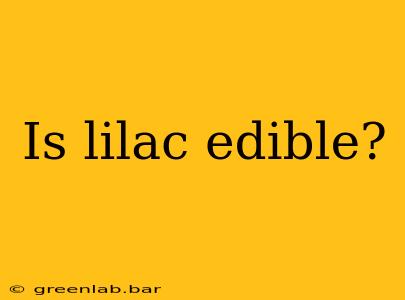The question of whether lilac is edible is a complex one, sparking curiosity among gardeners, cooks, and foragers alike. The short answer is: while technically not poisonous, lilac flowers are not recommended for consumption. This isn't simply a matter of taste; there are several reasons why you should avoid eating lilac blossoms.
Understanding the Risks of Eating Lilacs
While lilacs won't cause immediate, severe toxicity like some poisonous plants, consuming them carries potential risks. The flowers contain compounds that can cause:
- Gastrointestinal upset: Lilacs contain compounds that can irritate the digestive system, leading to nausea, vomiting, or diarrhea, particularly if consumed in large quantities.
- Allergic reactions: People with sensitivities to plants in the Oleaceae family (which includes lilacs, olives, and ash trees) may experience allergic reactions ranging from mild skin irritation to more severe symptoms.
- Lack of nutritional value: Unlike many edible flowers, lilacs offer minimal nutritional benefit. The calories and nutrients are negligible compared to the potential risks.
The Allure of Lilac's Fragrance and its Culinary Alternatives
The intoxicating fragrance of lilac blossoms is a hallmark of spring, tempting many to explore their culinary potential. However, their delicate beauty is best appreciated visually and through their scent. Instead of risking consumption, consider these alternatives:
1. Ornamental Use:
Lilac's beauty shines best in its natural habitat. Their vibrant clusters enhance gardens, providing a striking visual appeal.
2. Essential Oil Extraction:
Lilac's captivating fragrance is expertly captured in essential oils, widely used in perfumes, aromatherapy, and soaps. This allows you to enjoy the lilac scent without the risks associated with ingestion.
3. Explore Edible Flowers:
Numerous flowers offer both visual appeal and culinary benefits. Pansies, nasturtiums, and violas, for example, are safe and add vibrant color and subtle flavors to salads, desserts, and beverages. These alternatives provide a safe and flavorful way to incorporate edible blooms into your cooking.
Differentiating Lilacs from Edible Flowers: A Crucial Distinction
It’s crucial to distinguish lilacs from other edible flowers. Edible flowers are specifically cultivated and chosen for their safe consumption, offering a range of flavors and nutritional benefits. Thoroughly researching and identifying any plant before consumption is paramount to ensuring safety.
Conclusion: Appreciate, Don't Ingest
Lilacs are beautiful flowering shrubs prized for their fragrance and visual appeal. However, their culinary use is not recommended due to potential gastrointestinal distress and allergic reactions. Instead of risking consumption, appreciate their beauty in your garden or explore the wide array of safe and delicious edible flowers available for culinary adventures. Remember, safety should always be prioritized when considering the consumption of any plant.

